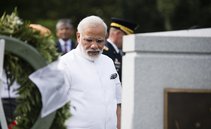India can unlock its potential and become a real economic competitor to China. How? Investing in infrastructure.

In 2024, India could begin to reap the fruits of what has been cultivated in the last two years, when New Delhi was the fastest-growing economy in the world. According to the International Monetary Fund (IMF), India’s real GDP will increase by a massive amount even over the next 12 months, when urbanization and industrialization processes could also reach a rapid take-off phase. Specifically, the Indian Elephant will grow slightly more than China (4-5%), twice as much as the world economy as a whole (3%), and four times as much as advanced economies (1.5%).
In general terms, India’s economy and demographics resemble those reported by Beijing in the late 1990s and early 2000s, indicating more than two decades of sustained rapid growth, as well as an associated huge increase in energy consumption.
Much - including the fact of becoming a real economic alternative to China - will however depend on how the Indian government manages to make the nation’s infrastructural system efficient, without which it will be impossible to get out of the quicksand in which, for a long time, New Delhi has been located.
India’s numbers
Before understanding if and how India is modernizing its infrastructure, it may be useful to read some statistics regarding the country’s economy. First, as the World Bank has highlighted, India’s real GDP per capita at purchasing power parity has risen to $7,100 in 2022, a level reached by China in 2007/08.
The United Nations then pointed out that the average age of the population has increased but is still low, at 27.9 years, i.e. as in Beijing in 1998, while population growth was on average 1.1% per year in the 10 years between 2012 and 2022, similar to China’s in the ten years from 1988 to 1998. And again: Indian energy consumption reached 26 gigajoules per person in 2022, the same as China in the early 1990s, while severe air pollution in Delhi and other major urban areas resembles northern cities in China in the 1990s and 2000s.
Between the economies of India and China, wrote Reuters, there are substantial differences, including the climate (Chinese cities are at much higher latitudes, so more energy is needed for heating) and the relationships between state-owned enterprises and the private sector, but also important similarities, including a large rural population ready to migrate to urban areas in search of better-paid work, as well as a large industrialization potential yet to be unlocked. Let us also remember that Indian real incomes are still less than half of those of China and a sixth of the average of those of advanced economies.
How India can close the gap with China
Can India unlock its potential and finally become an economic competitor to China? Yes, provided that New Delhi, as mentioned, imitates Beijing and invests large amounts of money in the construction of efficient and cutting-edge infrastructure. From this point of view, the next few years will be a litmus test for the nation’s ambitions to become an alternative production center to the Dragon.
As the Wall Street Journal pointed out, India’s creaking infrastructure, exemplified by potholed roads and accident-prone trains, has kept many big investors away from the country. The Narendra Modi-led government’s aggressive funding of specific infrastructure upgrade plans could allay some of these anxieties.
There is no shortage of early, timid examples. In 2018, New Delhi was an importer of smartphones worth more than $2 billion. Last year, however, it transformed itself into an exporter of the same products, reaching a value of 11 billion dollars. About half of the smartphones exported were Apple products, according to investment bank Macquarie, a company keen to find an alternative to China.
Between now and the next few years, therefore, other large multinationals could soon imitate the Cupertino giant. Also because something is actually moving in India. The pace of construction of highways has increased six-fold compared to levels from 2002 to 2010, the average speed of trains freight has increased by more than 50% in the last two years, and the waiting time in ports has decreased by 80% since 2015, while India’s road network has grown by around 40% in the last ten years to reach 6.3 million kilometers (the third longest in the world ).
In short, the country’s attention to supporting its poor infrastructure is fundamental to attracting dollars into the nascent manufacturing sector. A sector that accounted for just 13% of its gross domestic product last year, compared to 28% for China. It is urgent to change the register to seriously put the Dragon in the sights.
Original article published on Money.it Italy 2024-01-12 07:04:00. Original title: Cosa manca all’economia dell’India per raggiungere la Cina






